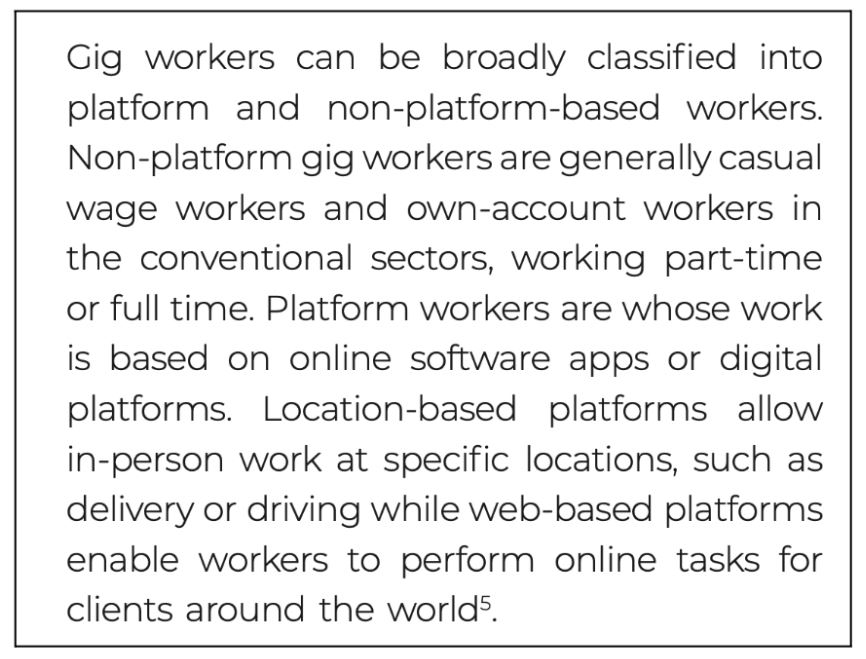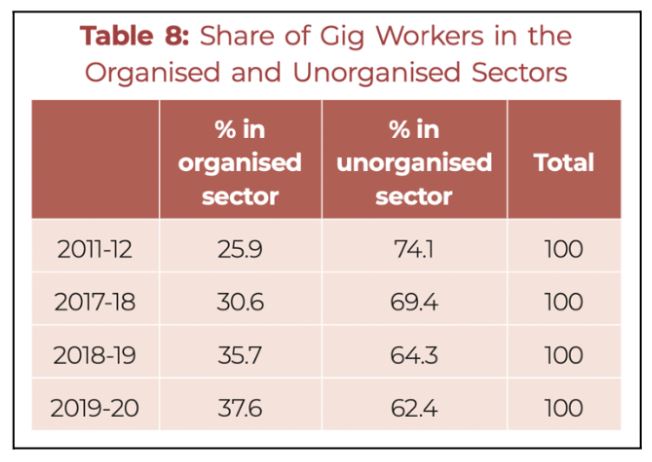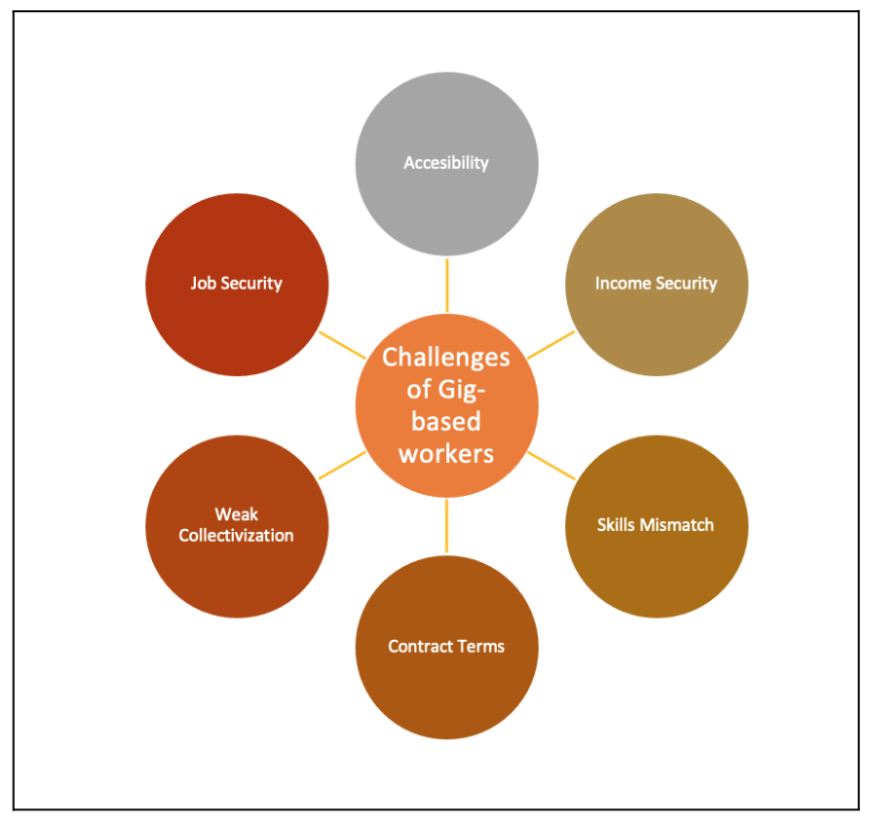NITI Aayog recently released a report on the Gig economy in India. Among other things, the report estimates the gig workforce to be 68 lakhs by 2019-20 and 77 lakhs by 2020-21. As per the estimates in the report, close to 60% of such workforce are in Retail & the Transportation sector. The report also identifies the challenges faced by the gig workforce.
Recent years have seen growth in the Gig economy. While freelancing & gig-based work is not a new phenomenon, the emergence of new technologies has opened multiple opportunities leading to reshaping of how work gets done. As of 2021, the gross volume of gig economy is estimated to be around USD 348 billion USD. India is also an emerging player, the importance of which is identified by the Government of India. The recent report of NITI Aayog – “India’s Booming Gig and Platform Economy: Perspectives and Recommendations on the Future of Work”, underlines this emphasis of the government.
What is Gig and Platform economy?
As per the definition by the UK government, which the World Economic Forum refers to, the Gig economy entails the transaction between two entities to get work done, which is short-term and task-based in nature, with digital platforms being the key enabler.

The usage of digital technology platforms differentiates and identifies the current concept of the gig economy from the more traditional independent workers. The number of such platforms has increased from 142 in 2010 to 777 in 2020 globally.
This differentiation is highlighted in the criteria laid down by NITI Aayog in its report as well.
It identifies a gig worker as a person who engages in income-earning activities outside of a traditional employer-employee relationship. These workers are classified into:
- Platform-based
- Non-Platform based
Platform workers are those whose work is based on online software apps or digital platforms. Meanwhile, non-platform gig workers are generally casual wage workers mostly engaged in conventional sectors. NITI Aayog’s study report focuses on the gig workers who are platform-based.

Gig-workers constitute 1.5% of the total workforce in the country as per 2020-21 estimates
NITI Aayog’s study report states that estimating the gig workforce in India is beset with challenges. Employees who identify as partners, individual workers taking up multiple tasks and contracts at the same time, etc. are a few of the challenges that leave severe data gaps to estimate the size of the gig economy.
The official data which has a robust system in place to estimate the conventional economy does not have enough data to estimate the number of gig & platform workers. The report has based its estimates on the limited data available along with the estimations from various research studies.
Among other studies, the report cites a study by Team Lease, which estimates that the gig workers in India have increased from 8.5 million in 2016 to 15 million in 2018. The study further notes that 56% of the new employment in the country is generated from the gig economy across both white-collar and blue-collar jobs. Another study states that 1.4 million of the 2.1 million blue-collar jobs in India are gig-based jobs.
NITI Aayog’s study identifies gig-workers based on their characteristics relating to 7 specifications – Location, Age, Education, Income Level, Type of Employment, Ownership of Mobile Phones & Bank Account (for online transactions).
Occupation & Industry of the workers was another criterion used for the estimates. The report also relies on the official employment data sets like – NSSO Employment and Unemployment Datasets, Periodic Labour Force Survey (PLFS), Labour Bureau Employment Survey, Annual Survey of Industries, CMIE Datasets etc.
Based on these, it is estimated that there are about 68 lakh gig workers in India in 2019-20. This includes both principal & subsidiary gig workers. Usual Principal Status (UPS) are those who spend most of the year as gig workers and Usual Subsidiary workers (USS) are those who spend a shorter period of the year.
Comparatively, the gig-workers in 2011-12 are estimated to be around 25 lakhs. UPS form the majority, whose number has increased from 24.5 Lakhs in 2011-12 to 67 lakhs in 2019-20. The share of the gig workforce out of India’s total workforce has also increased from 0.54% to 1.33% during this period. It is projected to increase to 1.5% in 2020-21. By 2029-30, it is estimated that there could be 2.35 crore (235 lakh) gig workers, and they could form 4.13% of the total workforce.
The study report states that the nature of the growth of the economy during the period has contributed to this increase i.e., the nature of economic growth was more conducive to gig workers while creating a less commensurate demand for non-gig workers.
Another important noticeable trend is the shift from unorganized sector to organized sector. During the period 2011-12 to 2019-20, the share of gig-workers in the unorganized sector fell from 74.1% to 62.4%. A major portion of gig workers is now part of organized sector. It increased from 25.9% in 2011-12 to 37.6% in 2019-20.

The highest number of Gig workers are in the Retail trade, followed by Transportation
In 2019-20, nearly 39% of the total Gig-workforce in India was in Retail trade. This is about 26.5 lakhs, 1.5 times higher than 10.6 lakhs in 2011-12. In 2019-20, another 19% i.e., 13 lakhs were engaged in transportation and storage. While the number of gig workers involved in these two sectors constitutes the major portion and has seen an increase, their share in the overall gig workforce has slightly fallen over the years.
This share is taken over by Real estate, construction & Information technology. In terms of absolute numbers, the other three industries that make up the top 5 in engaging gig-workforce include – Financial institutions, manufacturing, and Information technology.

With respect to occupation, 1/3rd of the gig-workforce in India are Shop/market salespersons & demonstrators. In 2019-20, 22.8 lakh were engaged as gig-workers in this profession. Motor vehicle drivers constitute the next highest portion of gig-workers, accounting for 13 lakhs of the 68-lakh gig-workforce in the country.
Workers engaged in secretarial & clerical jobs are next highest followed by Finance & Sales professionals. There are around 2.7 lakh computer professionals in 2019-20 engaged in gig jobs, which increased from 0.4 lakhs in 2011-12.
Job & income security, occupations safety are among the major challenges with gig-based work
While patronization i.e., using digital platforms to identify work has helped to formalize gig works, there are multiple issues identified internationally. The main issue is with the algorithmic control of the platform labour by digital platforms. Rating-based reputation systems, power of consumers/customers over workers, etc., facilitated by these platforms are said to cause significant risks and unfair working conditions to the workers.
The study report identifies that the gig-work in India also faces these challenges with the platforms. The report further takes cognizance of various other challenges faced by gig workers in India.
One of the major challenges is with job & income security. They are typically classified as independent workers or contractors and hence are not extended benefits from labour regulations relating to wages, hours of work, working conditions etc.
Accessibility is another issue with the availability of jobs depending on location (urban vs rural), gender, access to the internet etc. Varying degrees of skill-mismatch are observed on online web-based platforms, with workers with better qualifications not necessarily finding jobs.
Unfavourable terms of contract and non-collectivism of the gig workers are among the other challenges faced by gig workers.

While these challenges exist for gig-based jobs in the country, the study report notes that gig & platform-based jobs have contributed to inclusivity, especially for women and people with disabilities.
Creating a future-ready workforce, social security, enumeration mechanism etc. are among the recommendations of the report
NITI Aayog’s study report takes cognizance of the different challenges faced by gig workers in the country. The report has also identified the need to upskill the gig workers to take advantage of the existing and future opportunities. A few of the recommendations of the study report are the following.
- Undertake a separate enumeration exercise to estimate the size of the gig economy and identify the characteristic features of gig workers.
- Platform India initiative to catalyse Platformization.
- Accelerating financial inclusion.
- Skilling of the workforce through Outcome-based skilling, platform-led transformational skilling, platform skilling with government schemes etc.
- Integration and linking of employment and skill development portals.
- Enhancing social inclusion through gender sensitization & awareness programmes, inclusive systems & communication, self-development support etc.
- Paid sick leave, health access & insurance, occupational disease & work-accidental insurance, retirement & pension plans etc.
- Support to workers in situations of irregularity of work, contingency cover etc.
- RAISE framework for operationalizing the Code on Social Security to be adopted for gig & platform workers.
Featured Image: Gig economy in India


